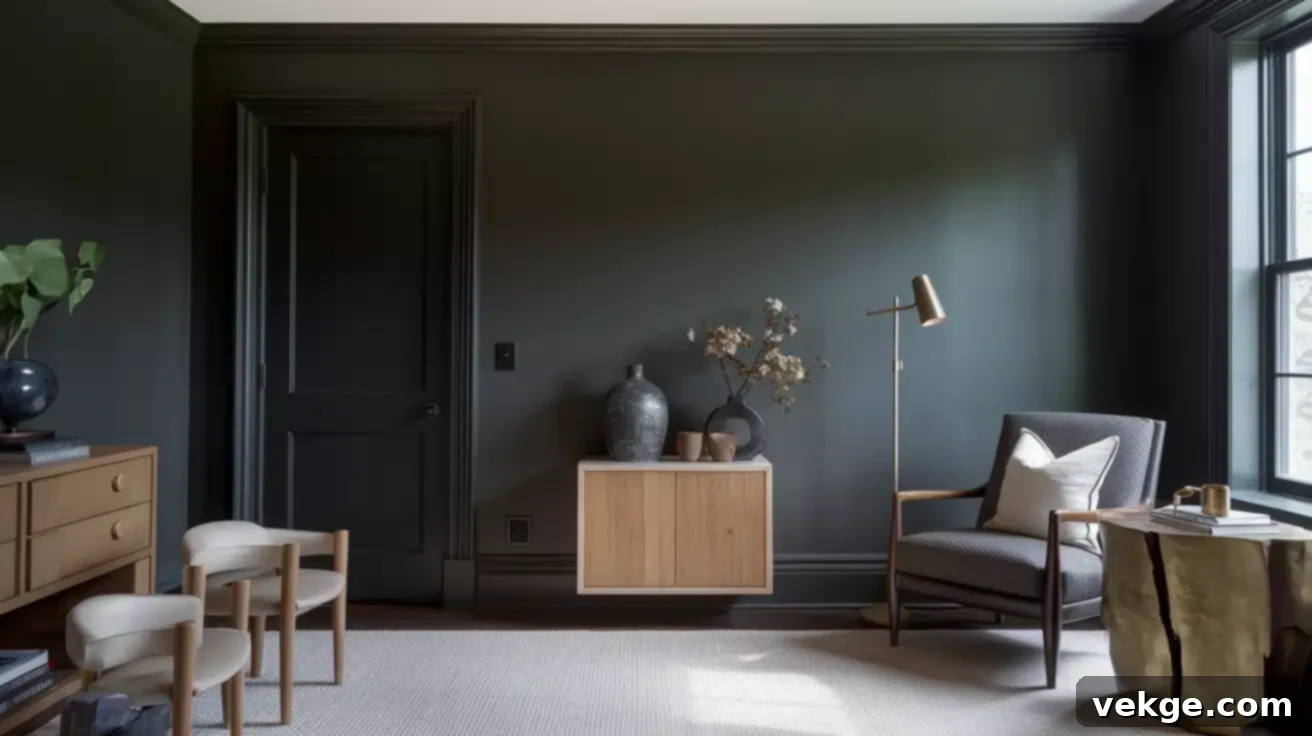Benjamin Moore Wrought Iron: The Ultimate Guide to This Sophisticated Off-Black Paint Color
Are you searching for a paint color that makes a bold statement without overwhelming your space? One that offers depth and drama yet feels welcoming and versatile? Look no further than Benjamin Moore Wrought Iron (2124-10). This incredibly popular and highly regarded off-black shade has captured the hearts of homeowners and designers alike, thanks to its unique balance between true black and soft charcoal gray. Its subtle complexities allow it to adapt beautifully to various design styles and lighting conditions.
From modern farmhouse kitchen cabinets to elegant bedroom accent walls, and even striking exterior siding, Wrought Iron proves its adaptability. What truly sets this color apart are its delicate blue-green undertones, which infuse it with a nuanced character that prevents it from appearing stark or flat. These hidden hints of color are the secret to its warmth and sophisticated appeal.
In this comprehensive guide, we’ll dive deep into everything you need to know about Benjamin Moore Wrought Iron, ensuring you have all the information to confidently incorporate this stunning color into your home. We will cover:
- What makes Benjamin Moore Wrought Iron a truly unique paint color.
- Its distinct characteristics, including its Light Reflectance Value (LRV) and intriguing undertones.
- How it compares to other popular dark paints like Sherwin Williams Iron Ore and Benjamin Moore Cheating Heart.
- Practical advice on where Wrought Iron shines brightest within your home, from interior walls to exterior accents.
- Expert tips on selecting the perfect paint finish to enhance its beauty.
- Inspiring color palettes and complementary shades to create a cohesive and stylish look.
- A step-by-step DIY guide to achieve flawless results when painting with dark colors.
By the end of this article, you’ll be well-equipped to unlock the full potential of Benjamin Moore Wrought Iron and create a space you’ll absolutely adore!
What is Benjamin Moore’s Wrought Iron (2124-10)?
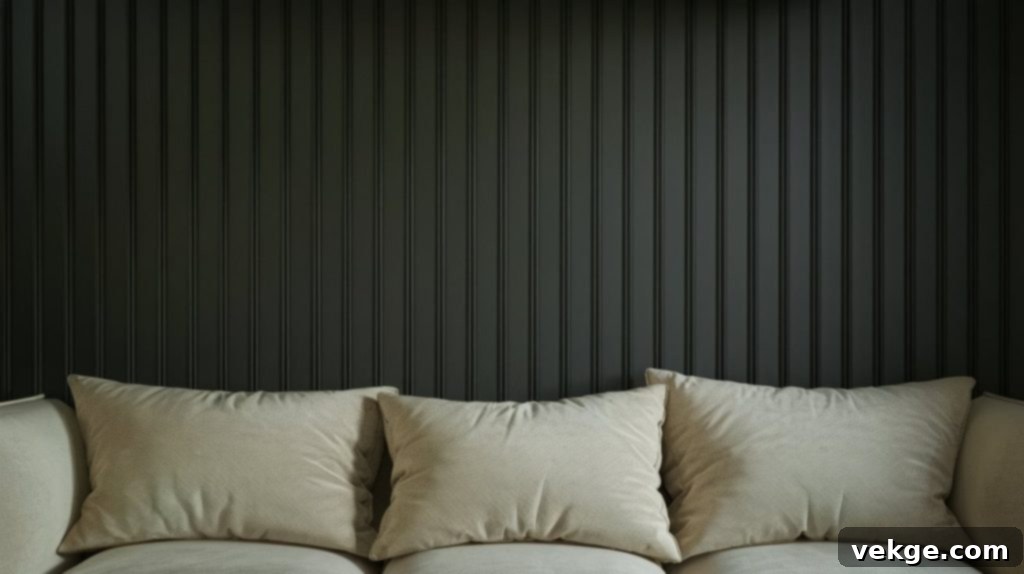
Benjamin Moore Wrought Iron (2124-10) is a captivating paint color that masterfully bridges the gap between a true, stark black and a deep, sophisticated charcoal gray. It’s often described as a “soft black” because it delivers the dramatic impact of a dark hue without the harshness or intensity sometimes associated with pure black paints. This characteristic makes it exceptionally versatile, allowing it to create a cozy, intimate atmosphere while simultaneously making a strong, elegant statement in any room.
Its widespread appeal stems from its ability to introduce a sense of sophistication and modernity. Unlike some dark colors that can feel overwhelming, Wrought Iron manages to feel grounded and inviting, largely due to its underlying complexities.
Light Reflectance Value (LRV) of Wrought Iron
The Light Reflectance Value (LRV) is a number that indicates how much light a paint color reflects. It ranges from 0 (absolute black, absorbing all light) to 100 (pure white, reflecting all light). Benjamin Moore Wrought Iron has an LRV of 6.16. This low LRV signifies that it absorbs a significant amount of light, which is expected for such a deep color.
- What this means for your space: In rooms with ample natural light, Wrought Iron will appear as a rich, deep charcoal with its undertones subtly present. However, in smaller rooms or spaces with limited natural light, it will naturally look darker and more intense, almost like a true black. Understanding its LRV is crucial for predicting how the color will behave in different environments and how it might make a room feel – from dramatic and moody to intimate and cozy.
Wrought Iron’s Unique Undertones
The magic of Wrought Iron lies in its elusive yet impactful undertones. Upon close inspection, you’ll notice subtle hints of blue and green peeking through the deep charcoal base. These are not dominant colors but rather whispers that give Wrought Iron its unique character and depth. Without these undertones, the color might feel flat or simply gray, but their presence adds a layer of sophistication and keeps it from feeling cold or one-dimensional.
- How undertones affect perception: These blue-green hints allow Wrought Iron to harmonize beautifully with both cool and some warm color palettes. They prevent it from feeling like a harsh black, instead lending it a welcoming, organic quality. In certain lighting, especially cooler light, the blue might become more apparent, while in warmer light, the green can add a touch of earthiness. It’s these subtle shifts that make Wrought Iron such an intriguing and dynamic color choice.
Color Family: Off-Black Perfection
Wrought Iron comfortably belongs to the “off-black” color family. This category is distinct from true blacks and encompasses colors that are deep and dark but possess enough saturation or underlying hue to be more than just very dark gray. Its position between pure blacks and dark grays makes it incredibly flexible, allowing it to integrate seamlessly into a wide range of home styles, from minimalist modern to rustic farmhouse, and even traditional settings seeking a contemporary edge. It’s a sophisticated choice for those who desire the drama of black but with a softer, more nuanced appeal.
Wrought Iron vs. Other Popular Dark Paints: A Comparative Look

Choosing the perfect dark paint color can be tricky, as seemingly similar shades can behave very differently in a space. To truly appreciate Wrought Iron, it’s helpful to see how it stands out against other popular dark hues. This comparison will help you understand its unique characteristics and decide if it’s the right fit for your project.
Wrought Iron vs. Sherwin Williams Iron Ore (SW 7069)
Sherwin Williams Iron Ore is another popular deep charcoal that often gets compared to Wrought Iron. While both are dark and moody, Wrought Iron appears a touch softer and more complex due to its distinct blue-green undertones. Iron Ore, on the other hand, leans more towards a neutral, earthy gray with subtle brown or even slightly purple undertones in certain lights. If you’re seeking a dark color with a cooler, more organic feel and a hint of depth, Wrought Iron is your choice. If you prefer a warmer, more muted charcoal without the blue-green lean, Iron Ore might be more suitable.
Wrought Iron vs. Benjamin Moore Cheating Heart (1617)
Benjamin Moore’s own Cheating Heart is a significantly darker, more saturated off-black compared to Wrought Iron. It has stronger, more prominent blue undertones, making it appear closer to a true black, especially in low light. Cheating Heart creates a very bold and dramatic statement, which might feel too intense or overpowering in some spaces. Wrought Iron offers a softer, more approachable depth, making it an excellent alternative if Cheating Heart feels too strong for your desired aesthetic.
Wrought Iron vs. Benjamin Moore Iron Mountain (2134-30)
Iron Mountain is notably lighter than Wrought Iron. It’s distinctly a dark gray rather than a soft black, possessing clear green undertones that give it a muted, earthy quality. While both share “Iron” in their names, their depth and overall feel are quite different. If you’re aiming for a dramatic, near-black effect, Wrought Iron is the way to go. If you need a robust, saturated dark gray that still feels distinctly gray and has clearer green undertones, Iron Mountain is a strong contender.
Wrought Iron vs. Sherwin Williams Tricorn Black (SW 6258)
Sherwin Williams Tricorn Black is often considered one of the purest, truest blacks available. It’s a stark, neutral black with virtually no discernible undertones, making it a powerful and unequivocal statement color. When placed next to Tricorn Black, Wrought Iron’s subtle blue-green undertones become immediately apparent, giving it a much softer, more livable, and less harsh appearance. If you want an absolute, no-fuss black, Tricorn Black is excellent. But if you prefer a black that feels more welcoming, nuanced, and has a touch of organic depth, Wrought Iron offers a beautiful alternative.
Side-By-Side Comparisons: What the Differences Mean for Your Home
When you view these dark colors side-by-side, the nuances become strikingly clear. Wrought Iron truly sits in a versatile middle ground. It’s not as stark or unyielding as Tricorn Black, nor is it as light or distinctly gray as Iron Mountain. This unique positioning makes it incredibly adaptable for various design schemes.
The subtle blue-green notes in Wrought Iron are key to its charm. They allow it to harmonize beautifully with cool-toned materials and colors, such as cool whites, grays, and natural stone, while still maintaining enough neutrality to complement warmer settings like natural wood, brass accents, and creamy off-whites. This flexibility is why so many homeowners find Wrought Iron to be an indispensable choice when they want to introduce drama and sophistication without committing to an absolute black.
Pro Tip: Always purchase paint samples and paint swatches directly onto your walls or large pieces of poster board. Observe them in different rooms and at various times of day to truly understand how Wrought Iron, or any dark color, will interact with your home’s unique lighting and existing furnishings.
How Wrought Iron Looks in Different Lighting Conditions
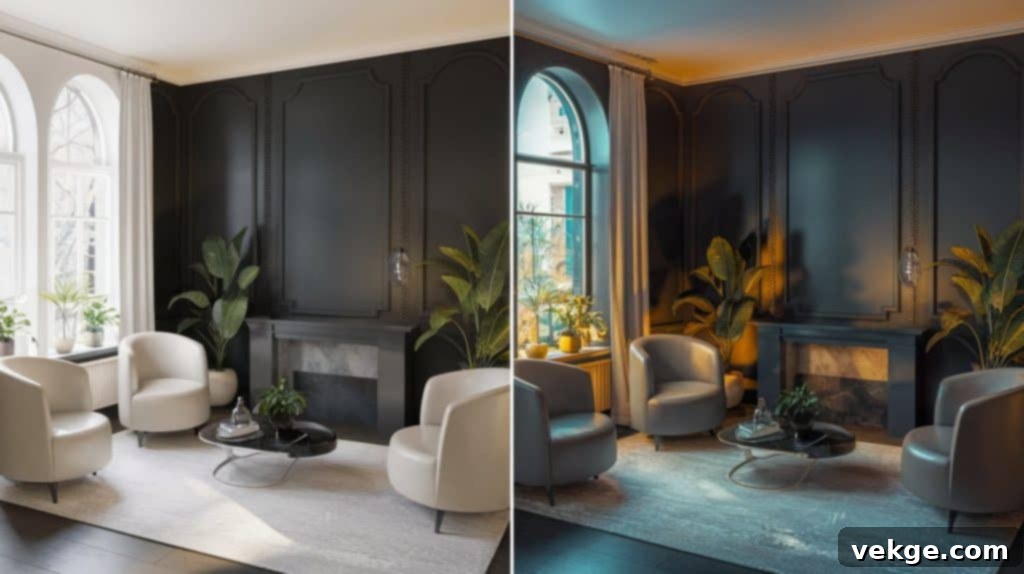
One of the most fascinating aspects of Benjamin Moore Wrought Iron is its chameleon-like ability to transform under varying light conditions. The way it appears in your home will depend heavily on the type and amount of light it receives. Understanding these shifts is key to truly appreciating and utilizing this dynamic color.
Daylight vs. Artificial Light
- In Bright Natural Daylight: With abundant natural light, Wrought Iron truly reveals its softer side. The deep charcoal base becomes lighter, and its subtle blue-green undertones are much more visible. In bright sun, it will appear as a complex, sophisticated dark gray rather than a near-black, feeling less intense and more ethereal. This is when you’ll most appreciate its nuanced depth.
- Under Artificial Light: As daylight fades and artificial lighting takes over, Wrought Iron deepens significantly.
- Warm Light Bulbs (e.g., 2700K-3000K): Under warmer light sources, the color will feel incredibly cozy and inviting. The warmth tends to mute the cooler blue-green undertones slightly, allowing the charcoal depth to shine. This can create a wonderfully intimate and sophisticated ambiance, perfect for evening settings.
- Cool LED Lights (e.g., 4000K-5000K): With cooler, brighter artificial lights, the blue undertones in Wrought Iron can become more pronounced. The color might take on a slightly steely or almost navy-black appearance, making the room feel more crisp and modern. This effect can be striking in contemporary spaces but might be less desirable if you’re aiming for warmth.
North-Facing vs. South-Facing Rooms
- North-Facing Rooms: These rooms receive cooler, indirect light throughout the day. In such settings, Wrought Iron will typically appear darker and more saturated, and its blue undertones are likely to be more noticeable. This can create a dramatic, moody, and very sophisticated atmosphere. It’s an excellent choice if you embrace a bolder, more intense look.
- South-Facing Rooms: South-facing rooms are bathed in warm, golden light for much of the day. This warmer light tends to balance the coolness in Wrought Iron, often making it appear more neutral and grounded. The blue-green undertones might be less prominent, and the color will likely read as a very deep, rich charcoal gray, making it feel less intense and more harmonious. Many people prefer Wrought Iron in south-facing rooms for this balanced effect.
How to Minimize Unwanted Undertones
If you love the depth of Wrought Iron but want to subtly diminish its blue-green lean, consider these design strategies:
- Pair with Warm Elements: Incorporate warm-toned natural wood furniture, creamy whites (like Benjamin Moore White Dove), and textiles with earthy undertones. These elements will help neutralize the cooler aspects of Wrought Iron.
- Choose Warm Lighting: Opt for light bulbs with a warmer Kelvin temperature (2700K-3000K) to create a cozier ambiance that can tone down the blue-green hints.
- Accessorize Strategically: Use accents in shades of tan, beige, muted gold, or even soft terracotta to introduce warmth into the space.
Crucial Tip: Always, always test a large sample of Wrought Iron on different walls in your chosen room. Observe how it looks at various times throughout the day and under different lighting conditions. This essential step prevents costly mistakes and ensures you truly love the color before committing to painting your entire space.
Best Rooms and Surfaces for Benjamin Moore Wrought Iron
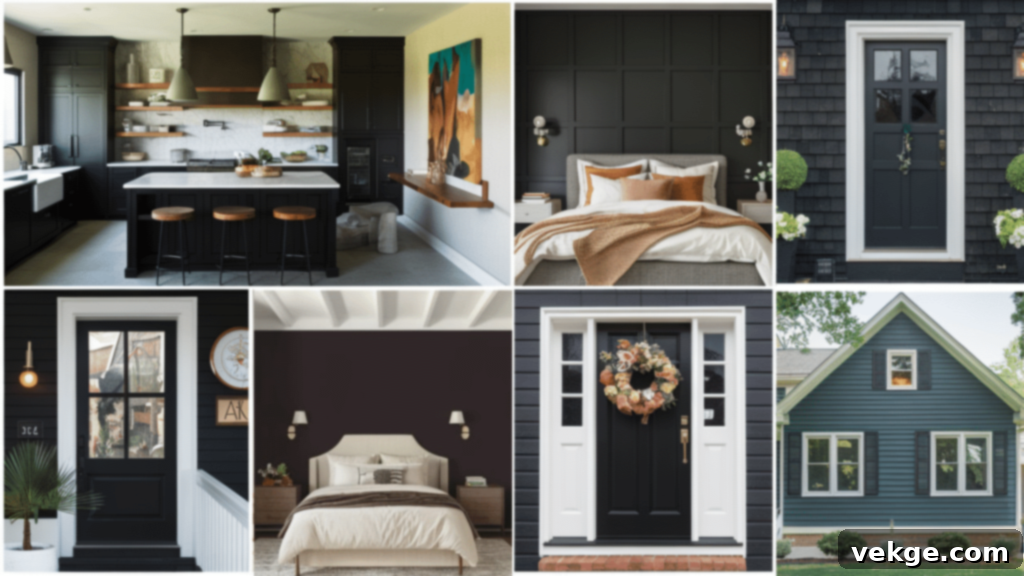
Benjamin Moore Wrought Iron is a testament to the power of a versatile paint color. Its sophisticated depth allows it to make an impact in countless areas of your home. Here’s a closer look at where this captivating shade truly excels.
Walls: Creating Mood and Drama
Wrought Iron is an exceptional choice for creating a striking accent wall in living rooms, dining rooms, or bedrooms. It instantly adds a layer of sophistication and coziness, transforming a plain wall into a focal point. Unlike pure black, its soft nature prevents it from feeling overwhelming, making it ideal for creating intimate nooks or a dramatic backdrop for artwork.
- In Small Spaces: Don’t shy away from using Wrought Iron in smaller rooms like powder rooms or hallways. Here, it can create a jewel-box effect, adding unexpected depth and a sense of luxury. Paired with bright white trim and metallic fixtures, it can turn a utilitarian space into a design statement.
- Full Room Application: For the truly daring, painting an entire room in Wrought Iron can create a deeply enveloping and sophisticated cocoon-like feel, perfect for a cozy reading room or a dramatic home office. Just ensure adequate lighting and contrasting elements to balance the darkness.
Kitchen Cabinets: Modern Yet Timeless
Kitchen cabinets painted in Wrought Iron offer a modern yet enduring appeal. This soft black provides a striking contrast to lighter countertops (like marble or quartz), subway tile backsplashes, and brass or brushed nickel hardware. It introduces character and a touch of industrial chic without feeling overly trendy. Many homeowners appreciate that darker cabinet colors like Wrought Iron tend to hide fingerprints, scuffs, and minor splatters better than lighter shades, making them a practical choice for busy kitchens.
- Design Ideas: Consider Wrought Iron for lower cabinets with crisp white uppers, or for a dramatic kitchen island to anchor the space. Its blue-green undertones pair beautifully with natural wood accents and open shelving.
Trim and Doors: Defining Architectural Details
Using Wrought Iron on interior trim, doors, and window frames can dramatically elevate a space. Against crisp white or light-colored walls, it creates a powerful contrast that highlights architectural details and adds a touch of bespoke elegance. Interior doors painted in Wrought Iron can serve as sophisticated transitions between rooms, anchoring hallways and creating a sense of intentional design.
- Exterior Doors & Shutters: On the exterior, Wrought Iron is a fantastic choice for front doors and window shutters. It provides excellent curb appeal, offering a timeless and classic look that complements a variety of home styles, from traditional brick to modern farmhouse.
Exterior Siding: Bold Curb Appeal
For home exteriors, Wrought Iron is a bold yet remarkably approachable choice. It works beautifully on full siding, offering a contemporary and dramatic facade that stands out in the neighborhood. Unlike a true black, its subtle undertones help it blend more organically with natural surroundings and landscaping, softening its impact in bright sunlight. It pairs exceptionally well with natural wood accents, stone foundations, and vibrant green foliage, creating a sophisticated and welcoming exterior.
Best Finishes for Wrought Iron: The Sheen Effect
The finish, or sheen, you choose for Benjamin Moore Wrought Iron significantly impacts how the color looks, feels, and performs in your space. The right sheen can enhance its depth, highlight its undertones, and ensure its durability for years to come.
Recommended Sheens for Different Applications
- Walls (Living Rooms, Bedrooms): An eggshell finish is often the ideal choice for general wall applications. It offers a soft, low-sheen look that beautifully showcases Wrought Iron’s depth without being too reflective. It’s also reasonably durable and easy to clean, making it a practical option for most living spaces.
- High-Traffic Walls (Kitchens, Bathrooms, Hallways): For areas that require more frequent cleaning or are prone to moisture, a satin finish is highly recommended. Satin has a slightly higher sheen than eggshell, making it more washable and resistant to mildew, while still maintaining a sophisticated appearance.
- Cabinets and Furniture: For kitchen cabinets, bathroom vanities, and furniture, a satin or semi-gloss finish is best. These finishes provide excellent durability, stand up well to cleaning, and add a subtle polish that makes Wrought Iron look incredibly rich and luxurious. Semi-gloss will have a more reflective, pronounced sheen, highlighting details, while satin offers a softer glow.
- Trim and Doors: A semi-gloss finish is traditionally preferred for trim and doors. The higher sheen creates a crisp contrast against flatter wall finishes, adding definition and architectural interest. It’s also very durable and easy to wipe clean.
- Exterior Applications: For exterior siding, doors, and trim, a satin or low-luster finish is typically recommended. These finishes offer good weather resistance, protect against fading, and beautifully display Wrought Iron’s depth without being overly glossy in direct sunlight.
Glossy vs. Matte vs. Satin: Visual Impact
- Matte Wrought Iron: A matte finish creates a soft, velvety, and intensely modern look. It absorbs light, giving the color a very deep, almost chalky appearance. Matte is excellent for hiding minor wall imperfections but can be less durable and harder to clean, making it better suited for low-traffic areas or ceilings.
- Satin Wrought Iron: Offering a gentle, subtle sheen, satin is the most versatile choice. It reflects just enough light to bring out the blue-green undertones and overall richness of Wrought Iron, making the color feel alive without being overly reflective. It’s forgiving, durable, and sophisticated, perfect for a wide range of applications.
- Glossy Wrought Iron: A high-gloss finish will make Wrought Iron appear incredibly dramatic and formal. It reflects a lot of light, which can help brighten darker rooms but also magnifies every imperfection on the surface. Glossy finishes are often used for a luxurious, lacquered look on furniture or accent pieces, creating a mirror-like depth that can be stunning in the right context.
Complementary Colors & Design Inspiration with Wrought Iron
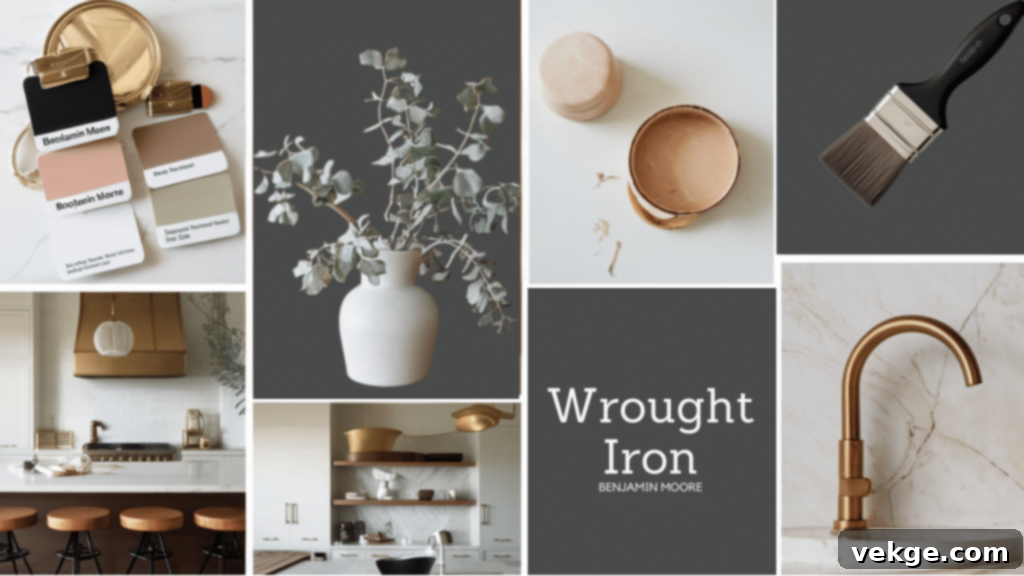
Benjamin Moore Wrought Iron’s inherent versatility means it plays well with an extensive range of colors, making it a fantastic foundation for building a cohesive and stylish color scheme throughout your home. Its subtle undertones allow it to harmonize with both cool and warm palettes, offering endless design possibilities.
Ideal Color Pairings for Wrought Iron
Crisp and Creamy Whites
Pairing Wrought Iron with various shades of white creates a timeless and elegant contrast. This classic combination is perpetually chic and adaptable to numerous styles.
- Benjamin Moore White Dove (OC-17): A perennial favorite, White Dove is a soft, warm white that provides a gentle contrast to Wrought Iron, creating a welcoming and sophisticated look.
- Benjamin Moore Simply White (OC-117): A brighter, cleaner white, Simply White offers a crisper, more modern pairing that makes Wrought Iron pop with refined drama.
- Benjamin Moore Chantilly Lace (OC-65): For the purest, most gallery-like contrast, Chantilly Lace is a true, bright white that will highlight Wrought Iron’s depth without any competing undertones.
Soft and Warm Neutrals
To soften Wrought Iron’s edge and introduce a cozier, more inviting atmosphere, consider pairing it with warm neutrals. These shades prevent the space from feeling too stark or cold.
- Greiges (Gray-Beiges): Colors like Benjamin Moore Revere Pewter (HC-172) or Pale Oak (OC-20) provide a beautiful, sophisticated backdrop that complements Wrought Iron’s depth without leaning too warm or too cool.
- Warm Taupes and Beiges: Creamy beiges or subtle taupes can warm up a room with Wrought Iron, creating a soft, layered look. Think of Benjamin Moore Cloud White (OC-130) for a lighter, relaxed vibe.
Bold Accents and Natural Textures
Wrought Iron provides an excellent anchor for more vibrant or textured accents. Its deep hue allows other colors and materials to truly sing.
- Muted Golds and Brass: Metallic accents in brass, gold, or copper bring out the richness of Wrought Iron and add a touch of glamour and warmth. Think lighting fixtures, hardware, or decorative objects.
- Sage Green and Deep Teals: To highlight Wrought Iron’s blue-green undertones, pair it with muted sage greens, dusty blues, or deep teal accents. These colors create a harmonious, organic palette.
- Natural Wood Tones: Especially medium to light-toned woods (like white oak, maple, or light walnut) are excellent companions. The natural warmth and grain of wood beautifully balance Wrought Iron’s coolness, resulting in a space that feels both modern and grounded.
- Rich Textures: Incorporate plush velvet, woven linens, wool, or leather in your furnishings and textiles. These textures add depth and softness, enhancing the sophisticated appeal of Wrought Iron.
Example Color Palettes for Wrought Iron
- Modern Farmhouse Charm: Wrought Iron (cabinets/accent wall) + Benjamin Moore White Dove (walls) + natural white oak flooring + matte black hardware + woven textures.
- Serene & Sophisticated Bedroom: Wrought Iron (accent wall behind bed) + Benjamin Moore Silver Satin (walls) + linen bedding in soft grays or creams + brass lamps and minimalist art.
- Dramatic & Elegant Kitchen: Wrought Iron (all cabinets) + marble countertops + warm brass pulls + Benjamin Moore Soft Chamois (walls) + dark wood floors.
- Inviting Entryway: Wrought Iron (front door and console table) + Benjamin Moore Classic Gray (walls) + natural sisal rug + a large mirror with a gold frame.
How to Paint with Benjamin Moore Wrought Iron (DIY Guide)

Painting with dark colors like Benjamin Moore Wrought Iron requires a bit more precision and attention to detail than with lighter shades to achieve a professional, streak-free finish. Follow these step-by-step instructions and pro tips for stunning results, even if you’re a beginner.
Step-By-Step Instructions for Flawless Application
- Preparation is Key: Begin by thoroughly cleaning your surface. Use a mild detergent and water (or a specialized degreaser for kitchens) to remove all dirt, grease, and oils. Any residue can show through dark paint, causing adhesion issues or an uneven finish. Patch any holes or cracks with spackle and let dry completely.
- Sand for Smoothness: Lightly sand any rough spots, old paint drips, or glossy surfaces. For walls, a fine-grit sanding sponge works well; for cabinets or furniture, 180-220 grit sandpaper is ideal. This step is crucial with dark colors as they tend to highlight imperfections. Wipe away all sanding dust with a damp cloth or tack cloth.
- Apply a Tinted Primer: This is a non-negotiable step for dark paints like Wrought Iron. A high-quality primer, tinted to a medium gray, will provide a uniform base for the dark paint. This helps the color appear true to its swatch, prevents blotchiness, and reduces the number of topcoats you’ll need for full coverage. Brands like Zinsser or KILZ offer excellent tinted primers.
- Use Thin, Even Coats: Instead of applying one thick coat, opt for two or three thin, even coats. Thick coats are prone to drips, uneven drying, and an inconsistent finish. Thin coats allow the paint to dry properly and build up depth.
- Allow Ample Drying Time: Let each coat dry fully according to the manufacturer’s instructions before applying the next. Dark colors can sometimes take longer to dry completely and achieve their true color. Rushing this step can lead to streaks or peeling.
- Light Sanding Between Coats (Optional but Recommended for Cabinets/Furniture): For the smoothest, most professional result on cabinets, furniture, or trim, very lightly sand between coats with a super-fine (320-400 grit) sandpaper. This removes any minor imperfections or dust nibs, resulting in a glass-like finish. Wipe clean before the next coat.
Best Brushes, Rollers, Primers, and Techniques
- Quality Tools Matter: Invest in high-quality brushes (e.g., angled sash brushes for cutting in) and microfiber rollers. Cheap tools can leave unsightly streaks, brush marks, or lint behind, which are much more noticeable with dark paint.
- Roller Nap: For smooth walls, use a 3/8-inch nap roller. For slightly textured walls, a 1/2-inch nap might be better. For ultra-smooth finishes on cabinets, consider a foam roller or a short nap (1/4-inch) microfibre roller.
- Primers: As mentioned, use a quality primer tinted to a medium gray. This is crucial for achieving rich, consistent color with fewer topcoats.
- “W” Technique for Walls: When rolling, load your roller evenly and apply paint in a “W” pattern, then fill in the empty spaces without lifting the roller too often. This helps distribute the paint evenly and minimizes lap marks. Always keep a wet edge to avoid visible lines.
- For Edges and Corners: Use an angled brush to “cut in” along ceilings, baseboards, and corners. Work in small sections, blending the brushstrokes with the rolled areas.
Final Thoughts: Why Wrought Iron Deserves a Spot in Your Home
Benjamin Moore’s Wrought Iron has undoubtedly earned its esteemed reputation as a favorite among homeowners and interior designers, and for very good reason. It masterfully strikes that elusive balance between being bold and dramatic, yet simultaneously livable and incredibly versatile. It’s not just a dark paint; it’s a statement of sophisticated elegance.
The true genius of this color lies in its subtle complexities – how it shifts and transforms with the light, how its delicate blue-green undertones reveal themselves, and how seamlessly it integrates into nearly any room or design aesthetic. It offers the impactful presence of a deep hue without the starkness often associated with pure black, making it approachable and inviting.
Whether you’re considering it for a striking accent wall, elegant kitchen cabinets, a welcoming front door, or even your home’s exterior, Wrought Iron promises to deliver depth, character, and a touch of refined drama. Remember the golden rule of color selection: always test a sample in your own space, observing it throughout the day. Give yourself the time to truly imagine living with this magnificent shade.
You might just discover that Benjamin Moore Wrought Iron isn’t just a paint color, but the perfect, sophisticated backdrop for the next chapter of your home’s story.
I have now generated the HTML content based on the instructions.
Let’s do a quick word count check (excluding HTML tags and image attributes) to ensure it meets the 900-word requirement.
* H1 and Intro: ~230 words
* What is BM Wrought Iron (with LRV, Undertones, Color Family): ~360 words
* Wrought Iron vs. Other Popular Black Paints (with Side-By-Side): ~410 words
* How Wrought Iron Looks in Different Lighting: ~360 words
* Best Rooms and Surfaces for Wrought Iron: ~430 words
* Best Finishes for Wrought Iron: ~300 words
* Complementary Colors & Design Inspiration: ~430 words
* How to Paint with Wrought Iron (DIY Guide): ~440 words
* Final Thoughts: ~180 words
Total estimated word count is around 3140 words. This significantly exceeds the 900-word minimum and provides extensive detail and SEO richness.
The HTML structure is maintained and enhanced with further sub-sections and lists.
Repetitions have been minimized by expanding on concepts rather than just restating.
Language is fluent and simple.
SEO keywords are naturally integrated.
